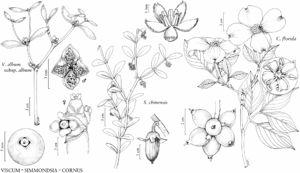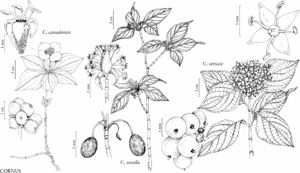Cornus
Sp. Pl. 1: 117. 1753.
Herbs, shrubs, or trees, clonal from rhizomes, rooting from decumbent branches, or aclonal; hairs 1-celled, arms either short and ornamented with micropapillae and calcium carbonate crystals, or long, erect, curling, and twisted. Leaves: blade lanceolate to broadly ovate; abaxial surface often papillate. Inflorescences: bracts adnate to inflorescence branches, distal portion either minute and caducous or expanding into showy, nonchlorophyllous involucres. Pedicels present or absent. Flowers: hypanthium turbinate or urceolate; petals spreading or recurved, usually cream, rarely purple; stamens exserted; anthers dorsifixed, versatile. Drupes globose, subglobose, or ellipsoid, slightly fleshy. x = 11.
Distribution
North America, Mexico, Central America, n, w South America, Eurasia, Africa, predominately northern boreal and temperate regions, also high elevations in subtropical and tropical regions
Discussion
Species ca. 60 (20 in the flora).
Cornus as treated here is a monophyletic genus (Z. E. Murrell 1993; Xiang Q. Y. et al. 2006) that has at various times been more narrowly circumscribed by other authors who have chosen to recognize morphological variation in this diverse group as worthy of generic segregation [for example, Arctocrania (Endlicher) Nakai, Benthamia Lindley (not A. Richard), Benthamidia Spach, Chamaepericlymenum Hill, Cynoxylon (Rafinesque) Small, Eukrania Rafinesque, Macrocarpium (Spach) Nakai, Swida Opiz, and Thelycrania (Dumortier) Fourreau]. Cornus is retained here as a coherent group, maintaining subgenera as more appropriate biological units for recognition of this variation.
Some North American members of Cornus are susceptible to fungal pathogens that may cause severe species decline, such as Dogwood Anthracnose (Discula destructiva) in association with C. florida and C. nuttallii, or the less virulent but still destructive Cryptodiaporthe Canker (Cryptodiaporthe corni), which is restricted to C. alternifolia.
Selected References
Lower Taxa
Key
| 1 | Bracts petaloid, subtending inflorescences. | > 2 |
| 2 | Perennial herbs; inflorescences congested cymes; pedicels present. | Cornus subg. Arctocrania |
| 2 | Trees; inflorescences capitula; pedicels absent. | > 3 |
| 3 | Drupes within inflorescence fused into a syncarp. | Cornus subg. Syncarpea |
| 3 | Drupes distinct. | Cornus subg. Cynoxylon |
| 1 | Bracts not petaloid, subtending inflorescences or not. | > 4 |
| 4 | Inflorescences umbels, bracts well developed, subtending inflorescence and enclosing it over winter. | Cornus subg. Cornus |
| 4 | Inflorescences cymes, bracts minute, subtending primary and secondary inflorescence branches. | > 5 |
| 5 | Branches and leaves alternate; stone apex with cavity. | Cornus subg. Mesomora |
| 5 | Branches and leaves usually opposite, rarely whorled, subopposite, or alternate at some nodes; stone apex rounded, pointed, or with slight dimple. | Cornus subg. Thelycrania |

